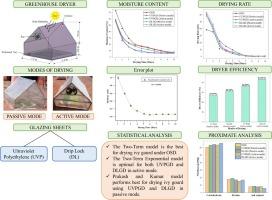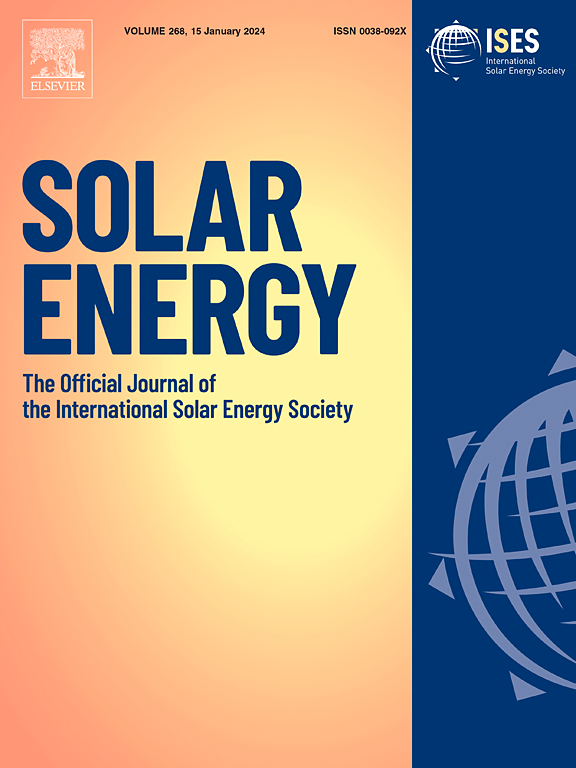Drying kinetics, energy, statistical, economic, and proximate analysis of a greenhouse dryer using different glazing materials for Coccinia grandis drying
IF 6
2区 工程技术
Q2 ENERGY & FUELS
引用次数: 0
Abstract
In this study, ivy gourd (Coccinia grandis) was subjected to various drying processes, including Open Sun Drying (OSD) and Greenhouse Dryer (GD), using different glazing materials such as Ultraviolet Polyethylene (UVP) and Drip Lock (DL) sheets in both passive and active modes. The dryer’s performance was assessed based on drying kinetics, energy, statistical, economic, and proximate analysis. In active mode, the DL sheet GD (DLGD) significantly reduced the moisture content of ivy gourd from 92.8 % to 10 % within 5 days, outperforming the UVP sheet GD (UVPGD), which required 6 days. In passive mode, the DLGD and UVPGD achieved the same result in 7 and 8 days, respectively, while OSD required 9 days for comparable moisture reduction. The dryer efficiency for UVPGD was 27.07 % in passive mode and 36.09 % in active mode. In contrast, the DLGD exhibited higher efficiencies of 30.93 % in passive mode and 43.31 % in active mode. Eleven mathematical models were considered to characterize the drying process of ivy gourd, with the two-term exponential model being the best fit for UVPGD and DLGD in active mode. The Prakash and Kumar model was found to be optimal for UVPGD and DLGD in passive mode. Economic analysis demonstrated that UVPGD in passive mode had the lowest capital cost and a payback period of 0.2985 years, whereas DLGD in active mode maintained payback periods below 0.5 years, indicating rapid cost recovery. Proximate analysis revealed that DLGD in active mode retained more carbohydrates, with percentages 8.3 %, 3.94 %, 3.29 %, and 2.17 % higher than OSD, UVPGD in passive mode, UVPGD in active mode, and DLGD in passive mode, respectively. Calcium retention was greater in active mode, while Vitamin C retention was higher in passive mode. The study identifies DLGD as the top performer across all modes, making it a recommended choice for commercial drying applications.

使用不同玻璃材料的温室烘干机烘干可可豆的动力学、能量、统计、经济和近似分析
在这项研究中,对常春藤葫芦(Coccinia grandis)进行了各种干燥处理,包括露天日晒干燥(OSD)和温室干燥(GD),在被动和主动模式下使用了不同的玻璃材料,如紫外线聚乙烯(UVP)和滴水锁(DL)板。根据干燥动力学、能量、统计、经济和近似分析对干燥机的性能进行了评估。在主动模式下,DL 片材 GD(DLGD)可在 5 天内将常春藤葫芦的水分含量从 92.8% 显著降至 10%,优于 UVP 片材 GD(UVPGD),后者需要 6 天。在被动模式下,DLGD 和 UVPGD 分别在 7 天和 8 天内实现了相同的结果,而 OSD 需要 9 天才能实现与之相当的水分降低效果。在被动模式下,UVPGD 的干燥效率为 27.07%,在主动模式下为 36.09%。相比之下,DLGD 的效率更高,被动模式下为 30.93%,主动模式下为 43.31%。有 11 个数学模型被用来描述常春藤葫芦的干燥过程,其中两期指数模型最适合主动模式下的 UVPGD 和 DLGD。Prakash 和 Kumar 模型被认为是被动模式下 UVPGD 和 DLGD 的最佳模型。经济分析表明,被动模式下的 UVPGD 资本成本最低,投资回收期为 0.2985 年,而主动模式下的 DLGD 投资回收期保持在 0.5 年以下,表明成本回收很快。近似物分析表明,主动模式下的 DLGD 能保留更多的碳水化合物,其百分比分别比 OSD、被动模式下的 UVPGD、主动模式下的 UVPGD 和被动模式下的 DLGD 高 8.3 %、3.94 %、3.29 % 和 2.17 %。主动模式的钙保留率更高,而被动模式的维生素 C 保留率更高。研究表明,DLGD 在所有模式中都表现最佳,是商业干燥应用的推荐选择。
本文章由计算机程序翻译,如有差异,请以英文原文为准。
求助全文
约1分钟内获得全文
求助全文
来源期刊

Solar Energy
工程技术-能源与燃料
CiteScore
13.90
自引率
9.00%
发文量
0
审稿时长
47 days
期刊介绍:
Solar Energy welcomes manuscripts presenting information not previously published in journals on any aspect of solar energy research, development, application, measurement or policy. The term "solar energy" in this context includes the indirect uses such as wind energy and biomass
 求助内容:
求助内容: 应助结果提醒方式:
应助结果提醒方式:


